I first saw the sign on a fresh April morning, when I was running in Kentish Town, north London. From a distance, it looked just like an ordinary house sign put up by estate agents, located as it was outside a smart Victorian townhouse. It was only as I neared it that I could see the words, in black sans-serif type on a white board:
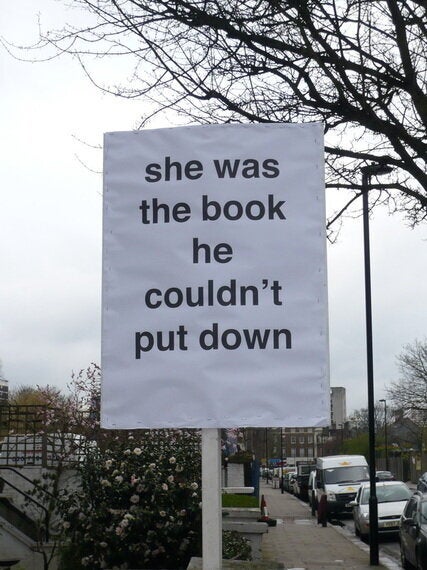
Perplexed, I took a picture of it, captioned it "Poetic house sign on a lovely street at 7.45am", and uploaded it to Instagram. I had no idea what it meant, or why it was there, but it had captured my imagination.
My writer friend Colin offered an explanation:
"I think I have worked out the mystery of the sign. Here, in the [imagined] words of the man who erected it, is what happened:
I stare into my coffee cup
In Starbucks, Kentish Town.
The girl I wish I could pick up,
The book I can't put down,
Rushed past me with a smile so sweet
And left me far behind,
And, as she runs along the street,
She's running through my mind.
How can I make her notice me,
This fleet-foot love of mine?
What if tomorrow she should see
An enigmatic sign
Outside my house that might impel
The curious observer
To think, and so to ring the bell.
I hope it won't unnerve her
When she enquires about the book
That kept me so engrossed
And I give her a smouldering look
As hot as buttered toast
And say I've seen her on the trail
And, since we're both book-lovers,
I want to read her (using Braille)
And get between her covers.
I'll offer her a steaming cup
Of coffee, rich and brown,
And, if I once can pick her up
I'll never put her down.
Ring the bell next time, if you dare, and see if I'm right..."
*
A week later, I ran past the sign again, and noticed that the words were different:
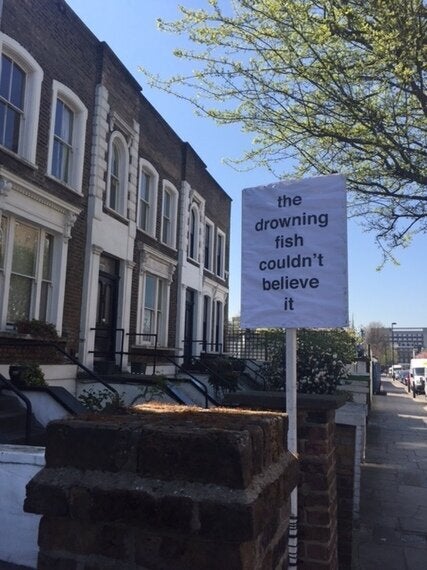
The other side of the sign said:
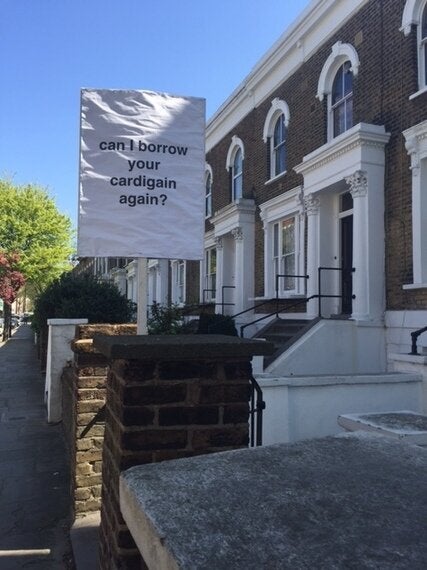
Were the words directed at a particular person, I wondered? Or were they merely there to entertain passersby? I was intrigued enough to walk up the steps of the house and ring the bell by the freshly-painted door.
It was a Thursday morning, so as I'd expected, nobody answered. But I was keen for clues as to the identity of the mystery poet, so stopped a middle-aged man who was walking slowly up the road.
"Excuse me," I asked him, "do you know anything about this sign?"
"He's been putting them up for years," he replied.
"Who has?" I asked.
"The man who lives there."
"Why does he do it?"
He laughed. "He probably has some kind of psychological problem."
It was all endlessly mysterious. For months, I kept running past the sign, and kept knocking at the door, but there was no answer. During this time, I encountered the following signs:
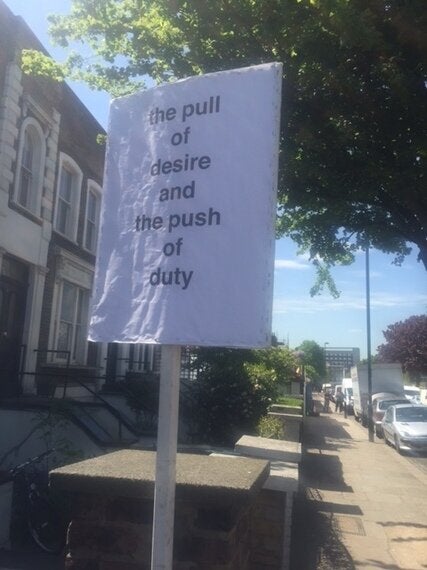
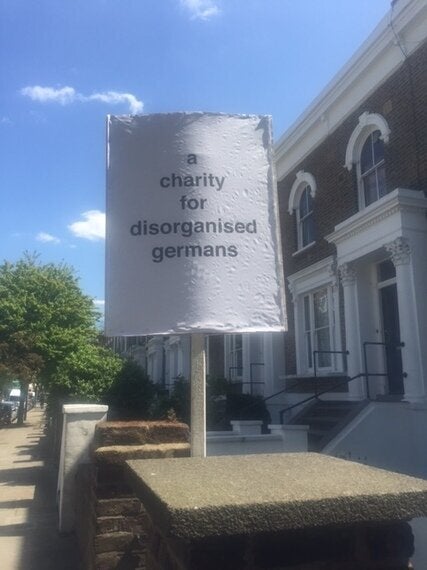
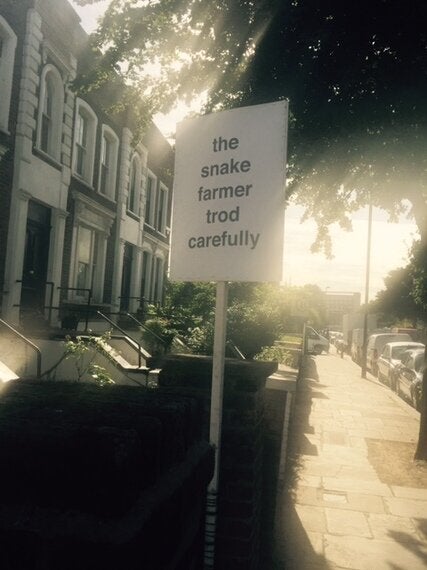
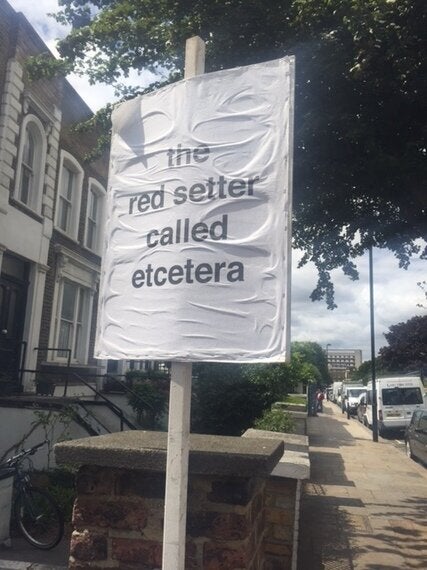
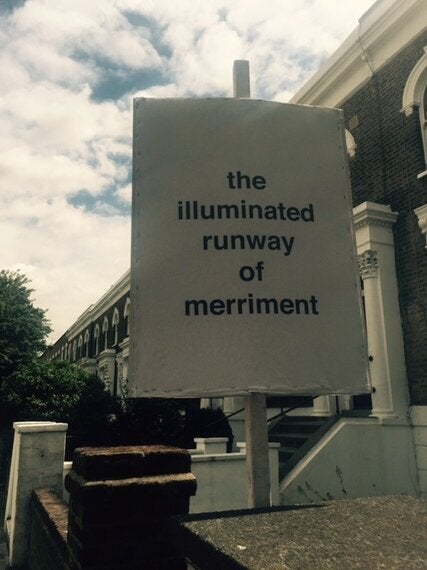
Eventually, determined to solve the mystery, I pushed a card through the man's door, explaining that I loved his signs. I asked if I could write an article about him, and gave him my contact details.
A day later, I received an email.
*
Mark Waddell is an affable, generous man in his 40s. Friendly and funny, optimistic and always ready with a joke, he is a pleasure to talk to. He used to work in art galleries and in art performance, along with a stint as an arts reviewer for The Scotsman and the Glasgow Herald, but now works with adults with learning disabilities. He takes them to art classes, art galleries, out sailing, and drives a minibus. "I turn the music up and we have a good time. It's great - I love it. I couldn't work in an office."
In his spare time, he writes poems and does illustrations, and has written me a fantastic poem. He also has a collection of poetry and illustrations coming out, on the cusp of greatness, which is being published later this year - but he knows what I want to focus on. "It's the signs that are interesting, isn't it? They're one of the best things I've ever done. The reactions are just brilliant."
When one of his signs referenced Bob Marley, passersby serenaded him with Three Little Birds. A tough man walking by was visibly moved by a sign saying "he married his childhood sweetheart and stayed true". His neighbours have told him the sign provides a talking point for them to bond with relatives, while Waddell has also discovered that he is big in Swaziland, as a local woman sends pictures of the signs to her son there, who uses them as educational tools. "[Finding that out] was pretty extraordinary," he says.
But not everyone has been so appreciative. Waddell once arrived home to find a note saying "Mr Signwriter, we have a problem." The note was from the local garage, letting him know that someone had forcibly ripped the sign out of the ground and flung it into the garage, where it had smashed the window of a van. Waddell paid for half the cost of the repair. "It wasn't my fault, but somebody reacted to my sign, so it felt like the right thing to do," he explains.
Another sign, saying "she was wearing a onesie when it happened", was also ripped down. "I'm convinced that someone walking down the street who's got a onesie at home went 'Oh no!'," he laughs. "But considering I've been doing it for a few years now, the reactions [have all been fairly positive]. Really, it's about brightening up the place."
Waddell got the idea for the signs when an estate agent sign was erroneously left outside his flat. He returned it to the estate agent, but as soon as he had left it there, "a light bulb went off inside my head and I saw the signs as they are now." He has now been putting up the signs for two and a half years, including a stint at the local Alma Street Festival, where he displayed 15 poetic signs along the road.
He thinks he will put up the signs forever. "It's part of me now, really," he confides. "If the sign's looking a bit tattered I get a bit edgy. I change them once every two weeks. I'd like to extend it, as well - using the TfL signs is my ultimate dream.
"People are bored at bus stops, so why not have a few messages coming up? I'd just love that. Positive things to make you feel better about your day; stuff to make you smile. Let's face it, I'm quite weird really, aren't I?" We both laugh.
No, I say, you're not weird, just original. And I mean it. Because how many people can say they innovate and put a smile on strangers' faces daily with their creativity? Before I leave, he hands me a wrapped present "to open when you get home".
It is a framed picture of a beautiful shot of a sign, saying "it's raining diamonds on jupiter". If only the world were full of Mark Waddells, it would definitely be a happier place.
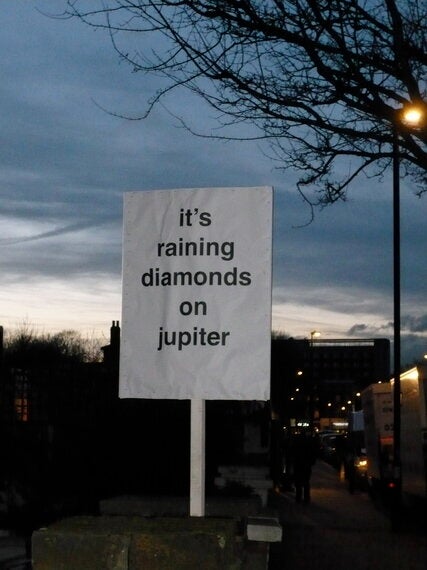
we are all statistics
'we are all statistics'
noted the statistician
as he stood on the beach
explaining
to the gathered children
that his cells
would stretch to the sun and back
61 times
and his
10 pints of blood
would be enough
to feed a colony of
100 vampire bats
for
20 days
and his
32 teeth
if made into an axe
would be able to chop through
13 feet of silver birch wood
before they broke
and he would
of course
have been able to work out
the chances of becoming
the first
collector and interpreter of numerical data
to be killed
by a suicidal seagull
if only
he had known.
Mark Waddell